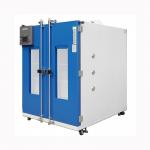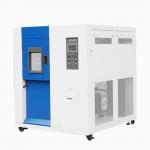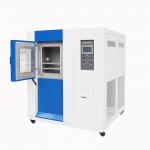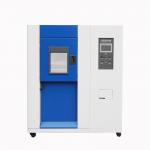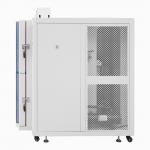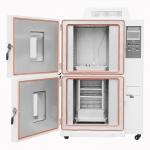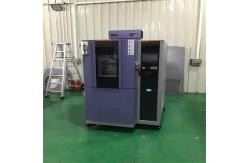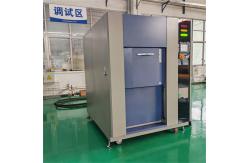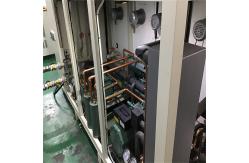In the highly competitive and safety-critical automotive industry,
the reliability and durability of vehicle components are of
paramount importance. Thermal Shock Test Chambers have emerged as a
vital tool for ensuring that automotive parts can withstand the
extreme temperature variations they encounter during their
lifespan. Thermal Shock Test Chambers for the Automotive Industry are
specifically designed to subject automotive components, such as
engine parts, electronics, sensors, and body materials, to rapid
and severe temperature changes. The primary purpose is to identify
any potential weaknesses or failures in these components due to
thermal stress. By simulating the harsh temperature fluctuations
that occur during vehicle operation, from the intense heat
generated by the engine to the cold of winter starts and the rapid
cooling during braking, manufacturers can optimize component
designs and manufacturing processes to enhance overall vehicle
reliability and safety. - Robust and Insulated Chamber Construction
- The chambers are built with heavy-duty, corrosion-resistant
materials to withstand the rigors of continuous testing. The
exterior is made of high-strength steel, providing protection
against mechanical damage and environmental factors. The interior
is lined with a smooth, non-reactive surface to prevent any
interaction between the chamber and the tested components. The
insulation used in the chamber walls is top-notch, ensuring minimal
heat transfer between the different temperature zones and
maintaining precise temperature control.
- The door of the chamber is engineered for a tight seal. It is
equipped with a reliable locking mechanism and a high-quality
gasket that guarantees an airtight closure. The door also features
a large viewing window, typically made of tempered glass, which
allows engineers and technicians to monitor the testing process
without disturbing the internal environment.
- Precision Temperature Control Systems
- The temperature control system is highly advanced and accurate. It
can achieve a wide temperature range, usually from -60°C to +200°C.
The system utilizes a combination of powerful heating and
refrigeration elements, along with a sophisticated feedback loop
and multiple temperature sensors strategically placed within the
chamber. This enables rapid and precise temperature changes, with
the ability to transition from one extreme temperature to another
in a matter of minutes.
- The temperature uniformity within the chamber is maintained within
±1°C, ensuring that all parts of the tested component experience a
consistent thermal environment. The system also has built-in safety
features to prevent overheating or overcooling, protecting both the
components and the chamber itself.
- Efficient Airflow and Transfer Mechanisms
- The chamber is equipped with a high-efficiency airflow system that
promotes rapid and uniform temperature distribution. The airflow is
carefully calibrated to minimize temperature gradients and ensure
that the components are exposed to the desired temperature as
quickly as possible. Additionally, the transfer mechanism between
the hot and cold zones is designed for speed and reliability. It
allows for seamless movement of the components from one temperature
extreme to the other, without significant temperature fluctuations
during the transfer.
- The transfer basket or rack used to hold the automotive components
is made of heat-resistant and non-conductive materials, preventing
any unwanted heat transfer or damage to the parts. It is also
designed to be easily removable for convenient loading and
unloading of the test specimens.
- Temperature Range: As mentioned, the chamber can operate from -60°C to +200°C. This
range is essential for testing a wide variety of automotive
components. For example, engine components like pistons and
cylinder heads need to withstand high temperatures during
operation, while exterior components like headlights and bumpers
must endure cold temperatures and rapid temperature changes.
- Temperature Transition Rate: The chambers can achieve rapid temperature transitions, typically
within 5 to 10 minutes. This rate is crucial for accurately
simulating the real-world thermal shock conditions that automotive
components experience. For instance, when a vehicle is driven from
a cold garage into a hot summer day or vice versa, the components
must be able to handle such rapid changes without failure.
- Uniformity and Stability: The temperature uniformity within the chamber is maintained
within ±1°C, ensuring that all parts of the tested component are
exposed to a consistent thermal environment. The stability of the
temperature in each zone is excellent, with minimal fluctuations
over time, allowing for accurate and repeatable testing.
- Accurate Simulation of Automotive Thermal Environments
- The main function of these chambers is to precisely replicate the
complex thermal environments that automotive components face. By
subjecting components to rapid temperature changes, manufacturers
can evaluate how well they perform under thermal stress. For
example, testing an engine control unit (ECU) under thermal shock
conditions can help identify any issues with its electronic
components, such as solder joint failures or changes in electrical
resistance, which could lead to engine malfunctions.
- The ability to program custom temperature profiles and cycling
patterns is also a valuable function. This allows manufacturers to
simulate specific driving conditions, such as stop-and-go traffic
in a hot city or long highway drives in cold weather. By testing
under these scenarios, they can ensure that the components are
reliable in all real-world situations.
- Enhanced Component Quality and Vehicle Safety
- Through rigorous thermal shock testing, automotive manufacturers
can improve the quality and reliability of their components. By
identifying and addressing potential weaknesses early in the design
or production process, they can reduce the risk of component
failures in the field. For example, if a brake sensor fails during
thermal shock testing, the manufacturer can modify the sensor
design or its manufacturing process to enhance its durability,
thereby improving vehicle safety.
- The test chambers also help in optimizing component design. By
understanding how different materials and designs respond to
thermal shock, engineers can make more informed decisions about
material selection and component geometry. This can result in
lighter, more efficient, and more reliable components, ultimately
leading to better-performing and safer vehicles.
- Compliance with Automotive Industry Standards and Regulations
- The automotive industry is highly regulated, and compliance with
standards such as ISO, SAE, and OEM-specific requirements is
essential. Thermal Shock Test Chambers are a reliable tool for
ensuring compliance. Manufacturers can conduct tests in accordance
with these standards and provide evidence of component durability
and safety. This is crucial for obtaining regulatory approvals and
building consumer trust.
- Regulatory bodies rely on accurate test results obtained from such
chambers to enforce safety and quality regulations. It serves as a
means for certifying that automotive components can withstand the
thermal stress they may encounter during normal vehicle operation,
protecting both drivers and passengers.
- Stringent Manufacturing Process
- These chambers for the automotive industry are manufactured under
strict quality control procedures. Each component, from the heating
and refrigeration units to the temperature sensors and insulation
materials, is carefully sourced and inspected for quality and
performance. The assembly process is carried out by highly trained
technicians in a clean and controlled environment, ensuring the
proper installation and functionality of all parts.
- The calibration of the temperature sensors and control systems is a
critical and regular part of the manufacturing process. It is
performed using traceable reference standards to guarantee the
accuracy and reproducibility of the test results. Rigorous quality
audits and inspections are conducted at various stages of
production to maintain the highest level of product quality.
- Quality Certification and Validation
Our chambers have obtained relevant quality certifications and have
been validated by independent automotive testing laboratories. They
have been proven to provide accurate and reliable test results,
conforming to the relevant automotive industry standards. We also
continuously update and improve our product based on the latest
technological advancements and customer feedback to ensure its
long-term performance and compliance.
|
